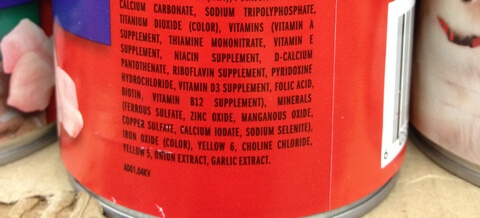Copper Sulfate in Dog Food — Is It Safe?
DogFoodAdvisor is reader supported See how
Dog Food Advisor is 100% impartial and is never paid to promote any brand. But if you buy using links on this page, we may earn a referral fee.

Once again, concerns about the safety of copper sulfate in dog food appear to be making their way around the Internet.
So, many of our readers have asked if it’s OK to buy dog food that includes this ingredient in its recipe.
For the answer, let’s take a quick look at the facts.
Why You’ll Find Copper
Supplements in Dog Food
Copper is an essential mineral for dogs, cats and humans.
So, you’ll nearly always find some form of copper on a dog food label.
That’s because in order to legally claim a product is “complete and balanced”, a dog food must contain the right amount of copper to meet AAFCO1 nutrient profiles.
How Much Copper Is Healthy?
According to the official 2015 AAFCO publication2, a dog food must contain not less than 7.3 mg of copper3 per each kilogram of dog food.
However, any mineral (even the sodium that makes up common table salt) can be toxic in excessive amounts.
Because some compounds of copper have such poor bioavailability for dogs, AAFCO does not permit copper oxide to be used to meet the association’s official nutrient requirements.
So, manufacturers must use copper sulfate…
Or a chelated form of the mineral, such as copper proteinate, copper complexed with an amino acid or polysaccharide…
To meet these guidelines.
Special Caution
with Liver-Rich Recipes
Some dog food ingredients naturally contain more copper than others…
Especially beef liver.
What’s more…
According to a more recent study…
Indiscriminately adding a mineral supplement to any recipe could lead to an increased risk of copper toxicity.
That’s why it’s so important to avoid buying food from companies that do not regularly test their products for nutrient content.
The Bottom Line
The personal interest story that was recently published in a local news paper appears to base its warnings about copper sulfate on a hypothesis proposed by one astute veterinarian.
And his theory is certainly worthy of further investigation.
Yet it’s important to keep in mind that as long as copper, or any other nutrient, is confirmed through testing by its manufacturer to be present in a dog food in a healthy amount, your pet should be considered safe.
For an enlightening scientific explanation on this topic, be sure to read this pet food industry article about copper sulfate.
It was researched and written by a respected animal nutritionist, Dr. Greg Aldrich of Kansas State University.
After reading Dr. Aldrich’s overview, you should be able to make a more informed decision whenever you notice copper sulfate on a dog food ingredients list.
Important Update
The original version of this article was published in 2015. Since then, a lot has changed regarding the topic of copper toxicity in dogs.
In a recent article published by Cornell University College of Veterinary Medicine, Dr. Sharon Center, professor of internal medicine, writes…
“…the excess amount of the essential trace mineral copper in commercial dog food can cause a serious, potentially lethal illness called dietary-induced copper-associated hepatopathy (CAH). The incidence of CAH is increasing at a rate that’s causing alarm among veterinarians and dog owners, with one study showing that 30% of canine liver biopsies have evidence of CAH.
“CAH is no longer considered just a disease of predisposed breeds like Bedlington Terriers, Labrador Retrievers, Dalmatians, Dobermans and Westies. First, it can happen to any dog, and it is expected to happen more and more if copper levels in dog foods remain too high. Second, it can be actively happening in the liver of a dog showing no outward signs of illness.”
In the same article, Dr. Joseph Wakshlag, professor of clinical nutrition at Cornell also adds…
“There is certainly a rise in copper-related hepatopathies these days… It may very well be related to a lack of safe upper limits of consumption and higher than expected levels in dog foods.”
We agree. It’s time for AAFCO to establish a safe upper limit for copper in its dog food nutrient profiles.
Final word
The Dog Food Advisor does not accept money, gifts, samples or other incentives in exchange for special consideration in preparing our reviews.
However, we do receive a referral fee from online retailers (like Chewy or Amazon) and from sellers of perishable pet food when readers click over to their websites from ours. This helps cover the cost of operation of our free blog. Thanks for your support.
For more information, please visit our Disclaimer and Disclosure page.




